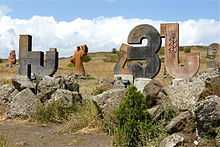Aparan
| Aparan | |
|---|---|
|
Aparan landmarks
Aparan skyline with Mount Aragats to the right Memorial to the Battle of Abaran • Mausoleum of General Dro Aparan Basilica • Alphabet park and the statue of Mkhitar Gosh Aparan metallic cross • Dusk over Aparan | |
 Aparan | |
| Coordinates: 40°35′20.81″N 44°21′25.97″E / 40.5891139°N 44.3572139°ECoordinates: 40°35′20.81″N 44°21′25.97″E / 40.5891139°N 44.3572139°E | |
| Country |
|
| Marz | Aragatsotn |
| First mentioned | 2nd century |
| Government | |
| • Mayor | Gor Abrahamyan |
| Area | |
| • Total | 3.5 km2 (1.4 sq mi) |
| Elevation | 1,880 m (6,170 ft) |
| Population (2009) | |
| • Total | 6,600 |
| • Density | 1,900/km2 (4,900/sq mi) |
| Time zone | GMT (UTC+4) |
| Website | www.aparan.am |
Aparan (Armenian: Ապարան), is a town in Armenia, located in the Aragatsotn Province, about 50 kilometers northwest of the capital Yerevan. Aparan was known as Bash Aparan (Բաշ Ապարան) until 1935. Throughout the history, the town was known with different names including Kasagh, Paraznavert, Aparanpol and Aparan Verin. It has a predominately Armenian population with a very small (~1%) minority population of Pontic Greeks and Kurds, numbering 5,711 as of the 2001 census.[1][2] The official population estimate in 2010 was 6,614.
Etymology and history
It is commonly believed that the name of Aparan is derived from the Armenian word of Aparank; meaning a royal palace.
The first reference to the town of Aparan was made by Ptolemy during the 2nd century. Ptolemy referred to the settlement as Casala; the Hellenized version of the Armenian name of Kasagh. It town was the centre of Nig canton of the Ayrarat province of ancient Armenia. Kasagh was under the administration of the Gntunyan Armenian noble family.
Starting from the 10th century, the settlement of Kasagh was mentioned as Aparan. The new name was originated from the village of Aparank located in the Moxoene province of the Kingdom of Armenia, when some remains from the ancient Armenian monastery of Surp Khach of Aparan were transferred to the town of Kasagh. However, the 17th-century Armenian historian Zakarya of Kanaker, used to name of Kasagh to refer to Aparan. During the 18th century, the town was known as Bash-Aparan. The town remained under the name of Bash-Aparan until 1935, when it was officially changed into Aparan.
being one of the oldest surviving churches in the Armenian highland, the famous Aparan Basilica of the Holy Sign of Cross was built by the end of the 4th century.[3] The church is undated and was partly restored in 1877.[3]
20th century and above
During the years of the Armenian Genocide, many Armenian refuge families arrived in Aparan from the Western Armenian cities of Van, Mush, Alashkert and Karin between 1914-1918. Many other families had also arrived from the Eastern Armenian town of Khoy.
The town was the site of the famous Battle of Abaran against the Turkish army on May 21, 1918 during the Caucasus Campaign of World War I, when the Turkish invasion of the newly independent Democratic Republic of Armenia was turned around. An impressive monument to the battle was erected in 1978 just north of the town.
Currently, Aparan has 3 public education schools and one musical school.
Aparan is famous for the production of rugs and carpets. The town is an important centre for dairy products as well.
Geography and climate
Historically, Aparan is located in Nig canton of Ayrarat Province of the Kingdom of Armenia Mayor.
Modern-day Aparan is built on the eastern slopes of Mount Aragats with an elevation of 1880 metres above sea level. The town is located 42 km north of Yerevan and 32 km north of the provincial capital Ashtarak, on Armenia's main north-south road that connects the Armenian capital Yerevan with the Georgian capital Tbilisi, passing through the cities of Spitak and Vanadzor.
Aparan has an Alpine climate in general with the influence of cold semi-arid climate. the town is characterized with snowy winters and mild humid summers. The average temperature is around -7°C in winter and 18°C in summer. The annual precipitation amount is between 450-600 millimetres.
Sites of Interest

- Aparan Basilica of the Holy Cross or Surp Nshan Basilica of Aapran, built during the 4th century.
- Monument to the Battle of Abaran erected in 1978.
- Mausoleum of General Drastamat Kanayan near the battle memorial, reburied in Aparan on 28 May 2000.
- Aparan Alphabet park and the statue of the 12th-century Armenian scholar Mkhitar Gosh.
References
- ↑ Report of the results of the 2001 Armenian Census
- ↑ Kiesling, Brady. Rediscovering Armenia Guidebook. Tigran Mets: 2001.
- ↑ 3.0 3.1 Thierry, Jean-Michel (1989). Armenian Art. New York: Harry N. Abrams. p. 545. ISBN 0-8109-0625-2.

